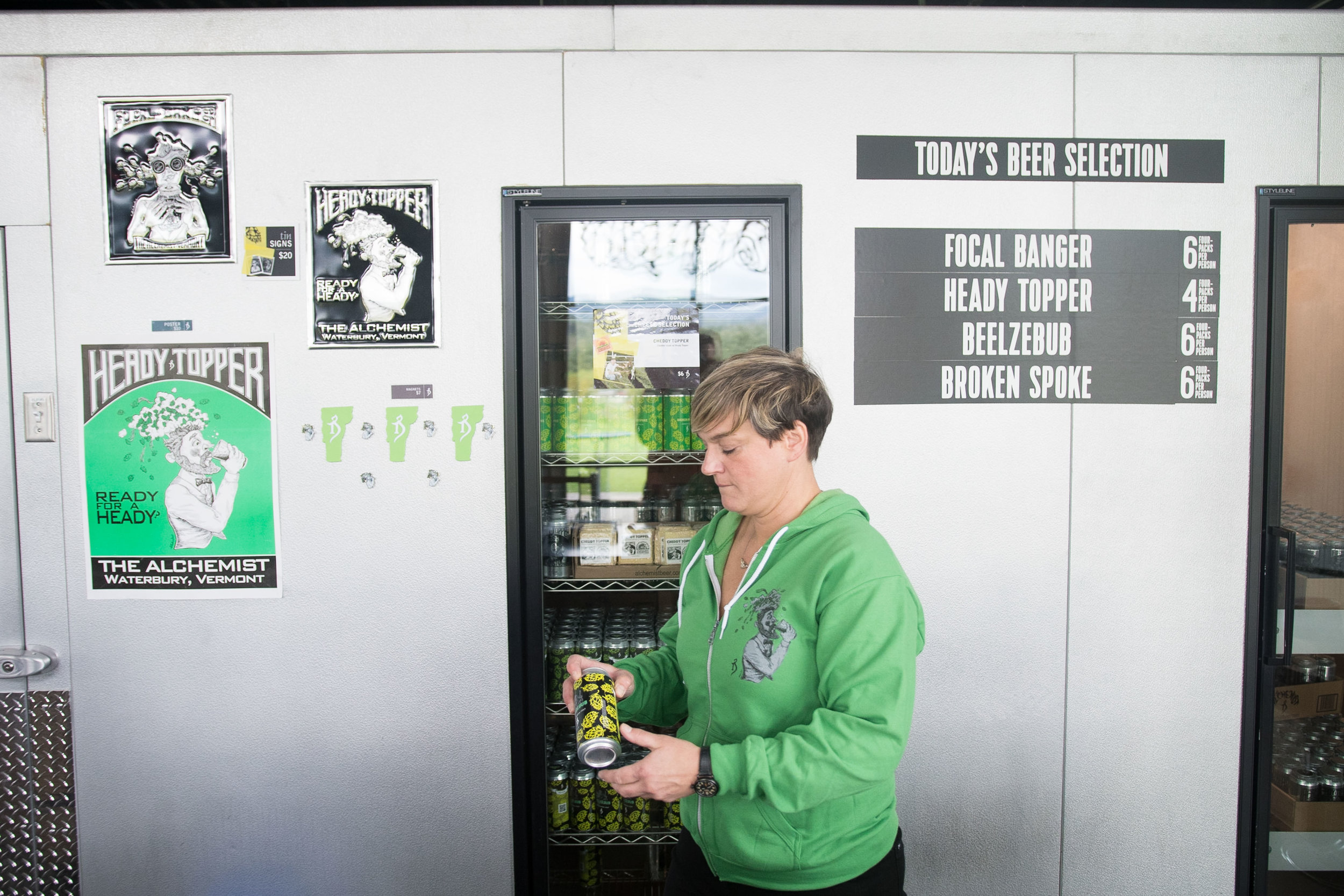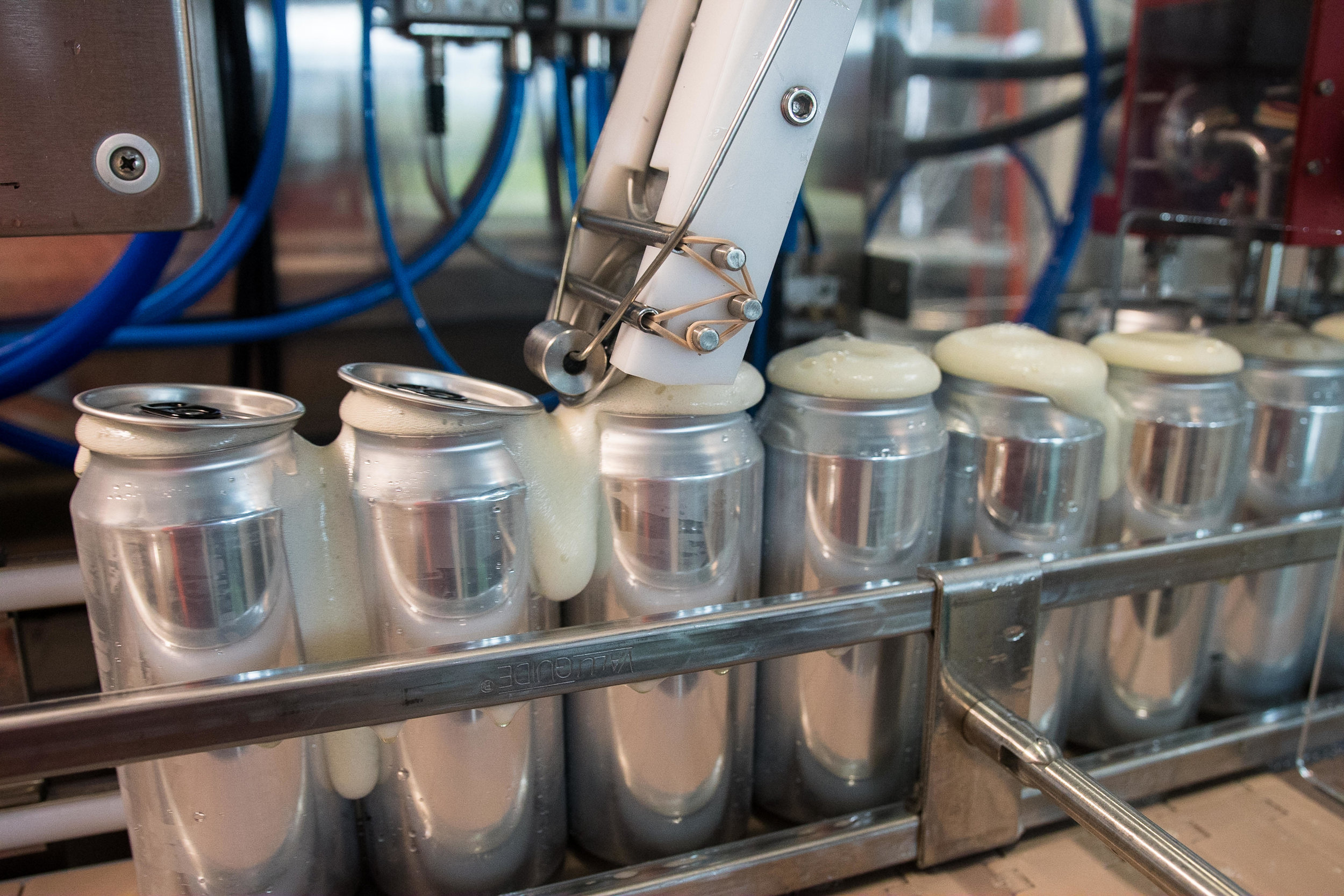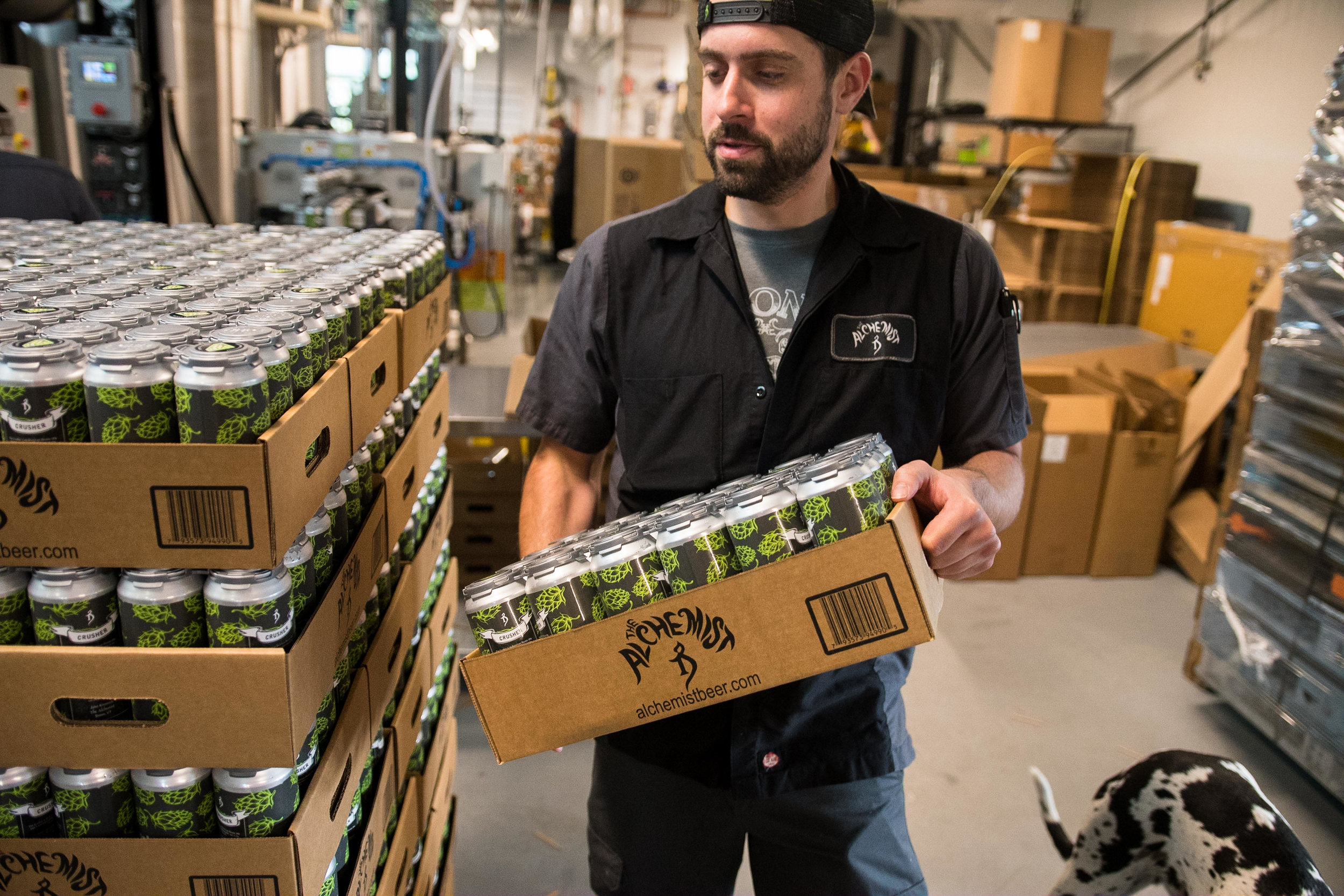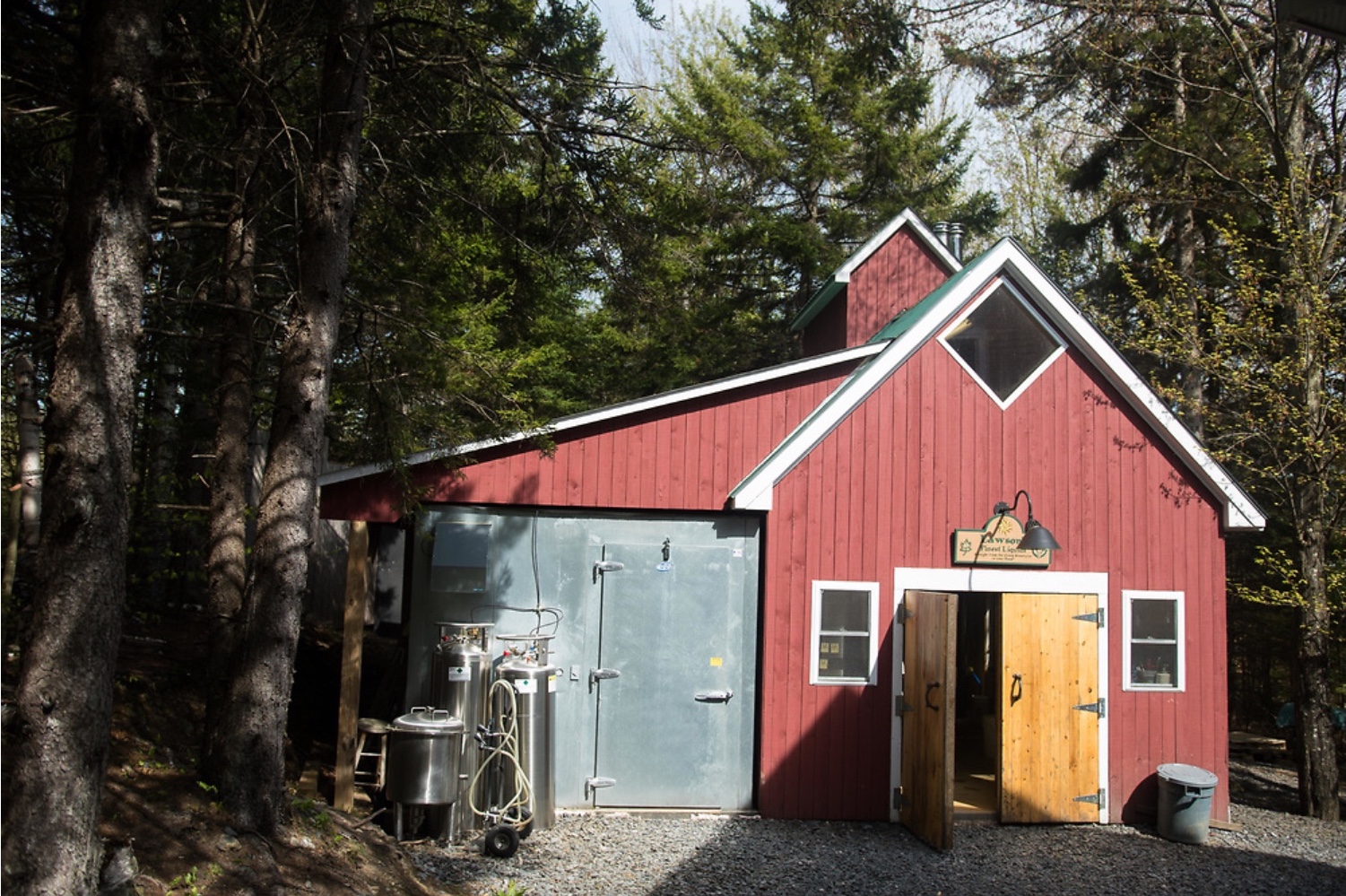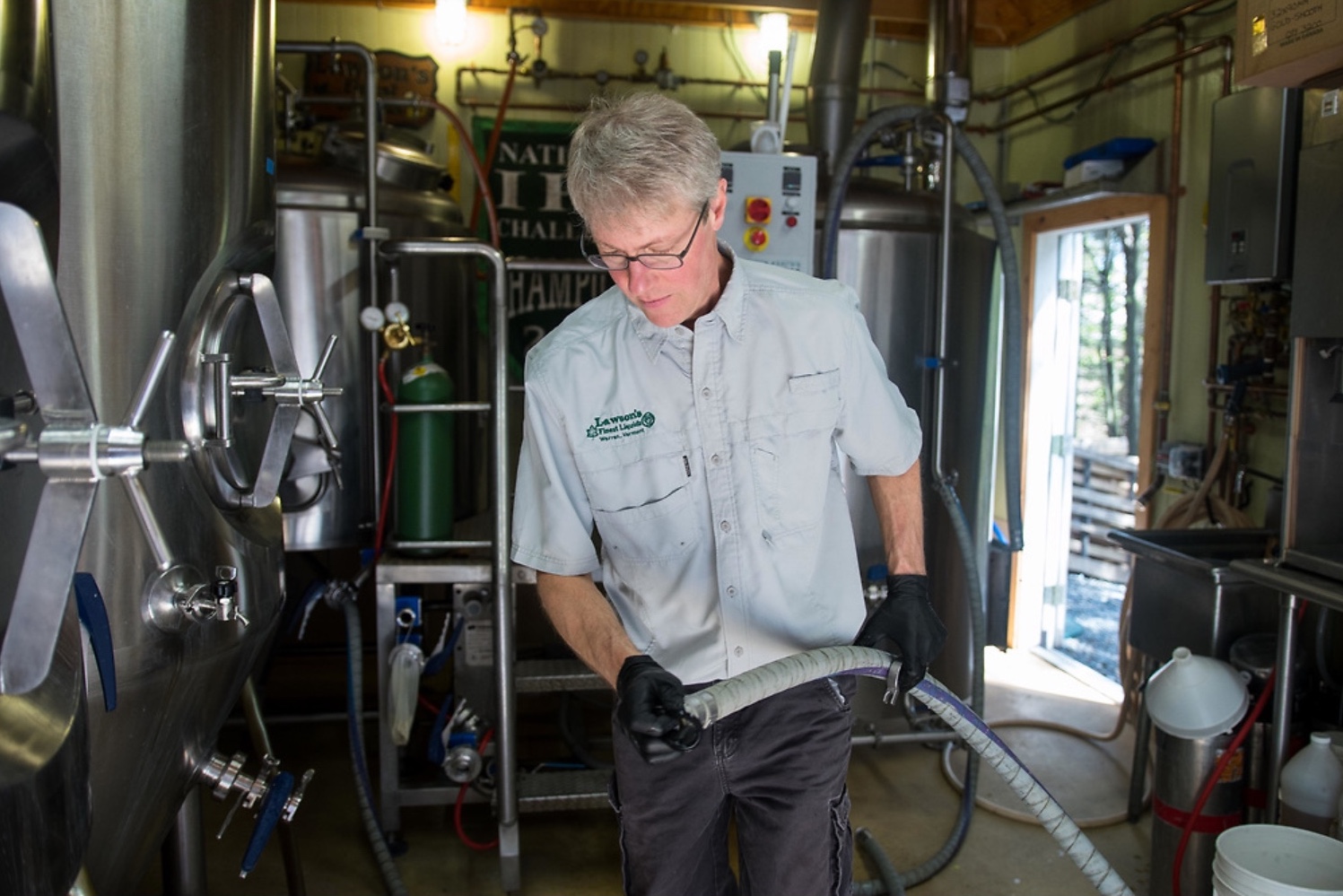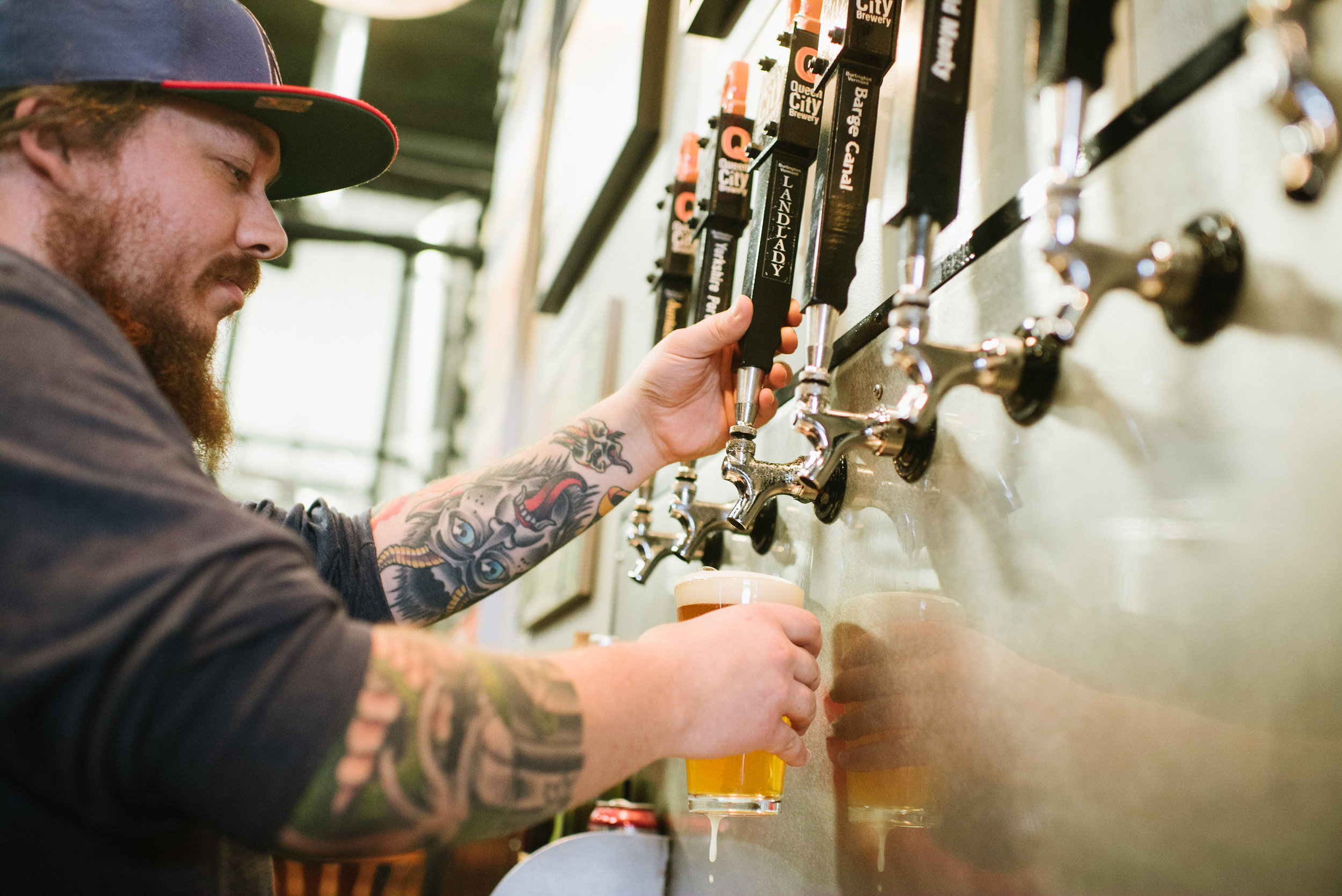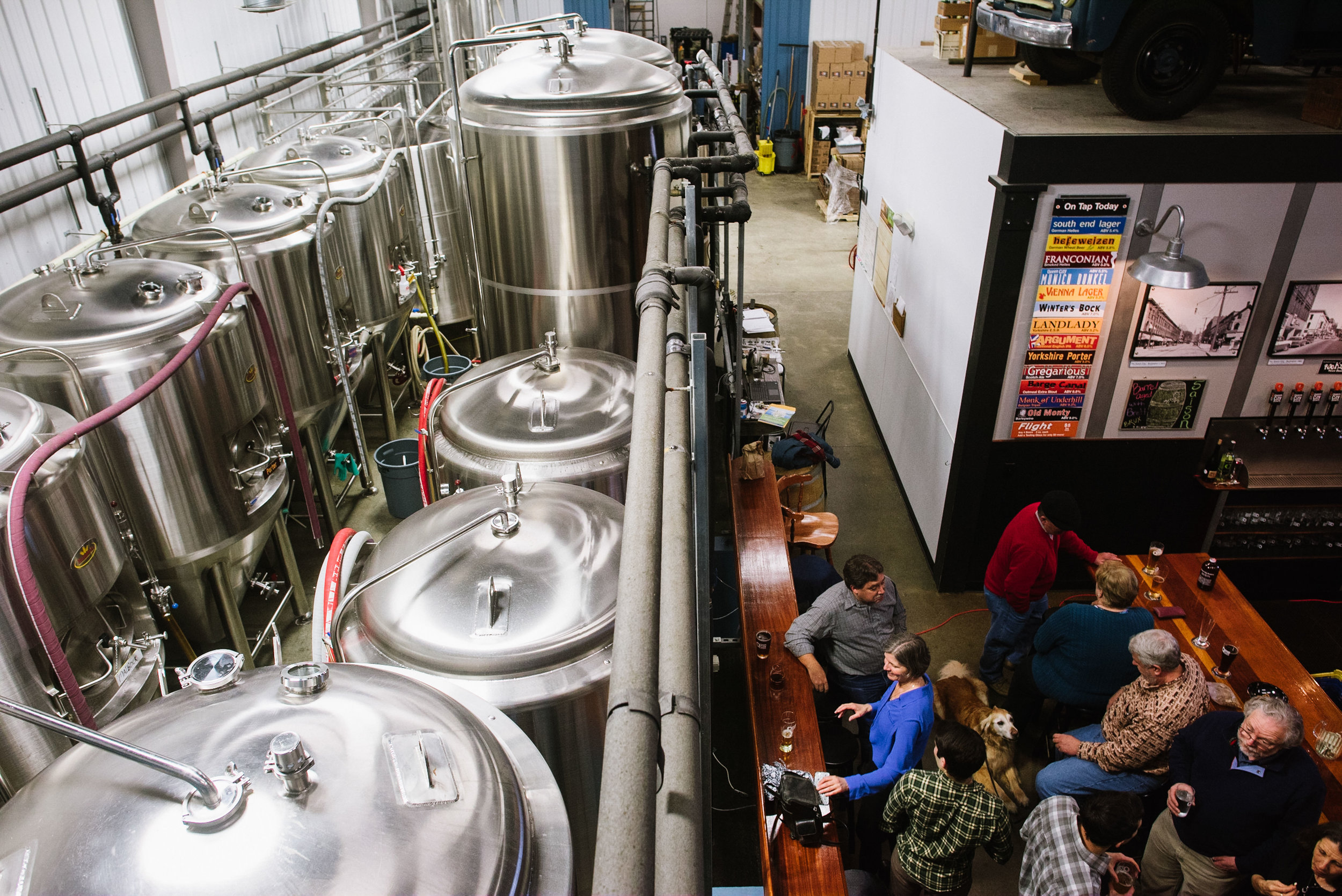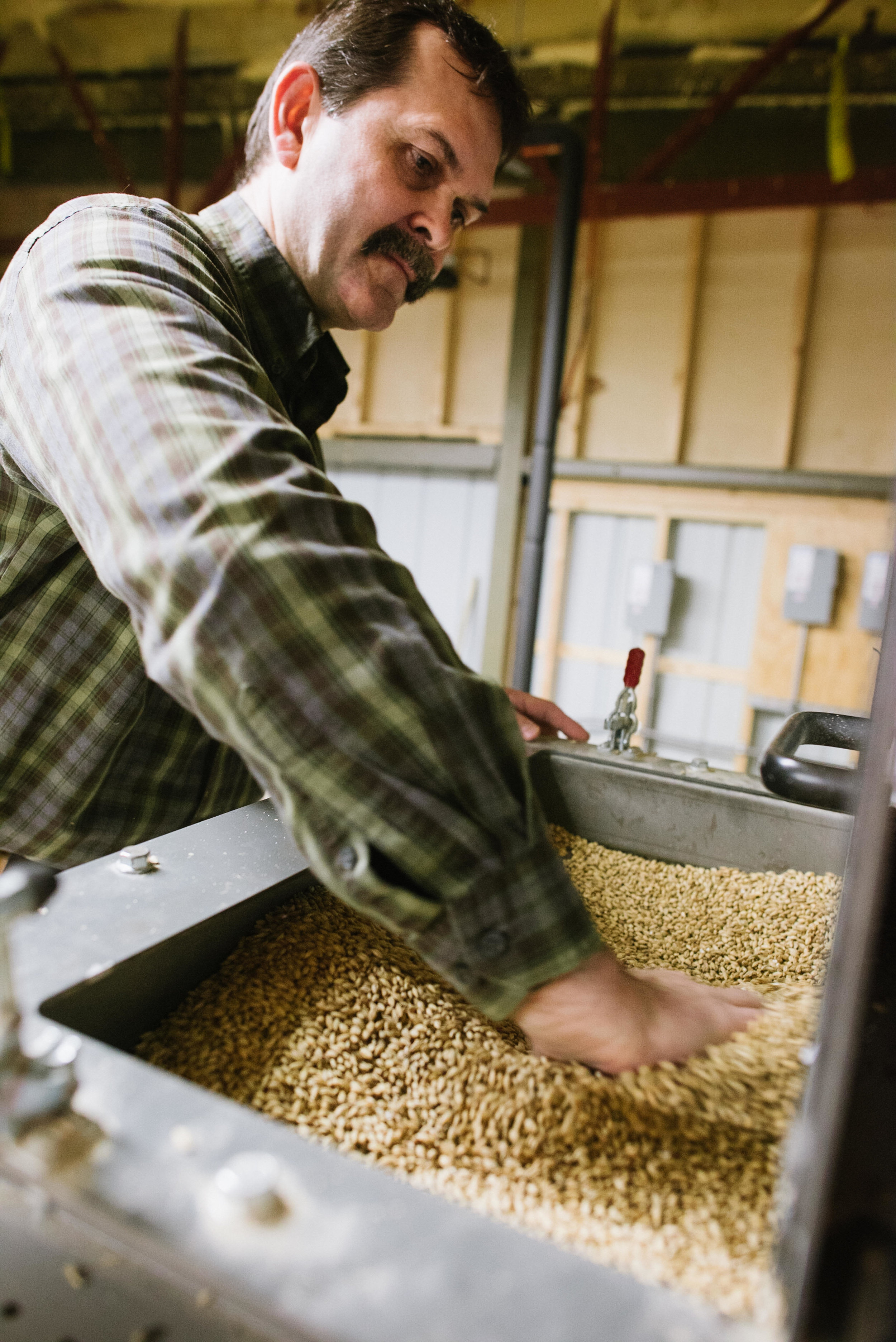The Craft of Brewing
Vermont is known worldwide for brews with a bite. UVM alumni have a lot to do with that.
By Andrea Estey // Photography by Andy Duback | July 2017
This article originally appeared in Vermont Quarterly
Home to Heady Topper, The Alchemist brewing facility in Stowe, Vermont.
ONE NIGHT IN 2011, while sitting on their living room floor, Jen Kimmich ’94 and her husband, John, designed their first can of beer: tall, with a whimsical black-on-silver illustration and an invitation to “drink from the can.” Within two years, the beer, Heady Topper, would become top-ranked in the world, and one of the most sought-after.
Heady was the first Vermont beer to generate a cult-like following. Because it’s only available in limited quantities within state lines, customers queue up, sometimes for hours, to buy it. “Heady Topper changed the attitude of the craft beer world,” says Adam Krakowski G’10, author of Vermont Beer: History of a Brewing Revolution.
Today, Vermont’s known as craft beer Mecca. People travel from all over the world to get a taste of what’s called the “Holy Trinity,” the three breweries widely considered to be the state’s best, two of which are owned by UVM alumni: The Alchemist, owned by the Kimmiches, and Lawson’s Finest Liquids, owned by Sean and Karen Lawson (’92 G’99 and G’97). (The third brewery in the trinity, Hill Farmstead, is not alumni-owned, but has been voted best in the world for the past three years.)
ECONOMIC UPPER
By all measures, Vermont’s beer scene is booming. From 2011-2015, the number of breweries in the state doubled, making Vermont first in the nation for craft breweries per capita. The Vermont Brewer’s Association (VBA) boasts fifty-four members, and expects to hit seventy within a year, says executive director Melissa Corbin ’00.
Besides making it tougher to decide what to order at the bar, all those breweries equal a shot of economic adrenaline for the state. According to a study done by VBA, in 2015, beer brought $367 million into Vermont (exceeding maple syrup and equaling on-mountain skiing) and created 2,000+ jobs. It’s also given birth to an entirely new tourist attraction, the Vermont “beer-cation.” For a growing number of customers, “it really is a quest to find the next great beer,” says Corbin.
Read on for a sampling of alumni you’ll find brewing in the Green Mountain State.
CRAZED FOR HAZE
It only takes one sip of Heady Topper to know it’s different. Hoppy and ultra-flavorful, the hazy, unfiltered double IPA was one of the pioneers of what’s now called the New England-style IPA.
Jen Kimmich appreciates customers’ enthusiasm. Just don’t call Heady “special.” “We just don’t think of it that way,” laughs Kimmich. “John makes great beer, but we focus on consistent quality and getting the best ingredients. All those years it was rated top beer in the world, it was taboo. You have to tune that stuff out because you can get sidetracked.”
Kimmich has both a pragmatic and people-focused approach to the business, a combination that can be traced back to her days at UVM. A Barre native and second-generation Catamount, she studied business administration for three years before falling in love with sociology. “That’s what grabbed me,” says Kimmich.
The late Professor Stephen Berkowitz had a particular impact on her growth; she remembers him as both mentor and friend.
Kimmich worked her way through college at Vermont Pub & Brewery, where she met future husband John. He migrated to Burlington after graduating from Penn State to work with the late Greg Noonan, then-owner of the pub and a pioneer in the state’s craft beer scene.
Soon after marrying, John and Jen got to work on their business plan, with Jen focused on finances and logistics and John honing recipes. They studied the business from the inside out, working for breweries in Jackson Hole and Boston before returning to Vermont in 2001. Their Alchemist Pub & Brewery was quickly a hit in Waterbury Village. “When we opened the pub, we were content, that’s kind of all we dreamed of doing,” says Kimmich. “But I knew that our beer would do great on the market because there was nothing like it. John finally gave in when I showed him the numbers.”
The first cans of Heady Topper came off the line in August 2011, the day before Hurricane Irene slammed Vermont, destroying the pub. “The timing was crazy. It was just a horrible day. But we knew we could overcome it.”
Fast forward to today: In addition to a Waterbury production facility, the couple operates a brewery/visitor’s center in Stowe, a massive, 16,000-square foot warehouse on four acres that offers expansive views of the surrounding slopes.
In total, The Alchemist employs forty-nine people; forty-eight are salaried. “Our base salary is twenty-eight dollars an hour,” says Kimmich. “We’re giving people job security. We work together, we’re a team, and because of that, we don’t have any turnover.” Benefits include full insurance, a 401(k) program, even fitness classes with an in-house wellness director. “The most important thing we do is invest in our community and our employees,” says Kimmich.
The brewery is doing so well, they started The Alchemist Foundation, which is in its fifth year of awarding scholarships to local students to further their education. “If you ever told us we would be this big, I would have said no, we don’t need this money, we don’t need all this,” Jen Kimmich says (pictured below, in green). “But when you’re given the opportunity to create jobs and make good, positive impact, you have a responsibility to follow through. We want to make a lot of positive change.”
MAD SUCCESS
Forty-five minutes south of Alchemist HQ, Sean and Karen Lawson of Lawson’s Finest Liquids are poised to make a similar impact in the Mad River Valley. For the past decade, Sean’s been cooking up standout brews in a tiny sugar shack on his property. Now, the Lawsons are working on opening a tasting room and brewery in downtown Waitsfield next summer.
“It’s exciting, but daunting. We really are mom and pop,” says Lawson, who swiftly labels bottles by hand as he talks. “We just hired our first employee, and we’re going to need to hire between twenty and twenty-five people next year. We’re going to create some really good jobs.”
A New Jersey native, Sean grew up visiting family in Vermont, including his uncle, professor emeritus Bob Lawson, now retired from the psychology department after forty-four years at UVM. “From a young age, I felt like Vermont was a place I wanted to be,” says Sean. He graduated in 1992 with a degree in environmental studies and ecology, around the time he cooked up his first batch of homebrew, a maple wheat beer made in a big turkey pot in his off-campus apartment.
He worked as an environmental researcher, naturalist, ski patroller, and even at a few brewpubs before returning to UVM for his master’s in forestry. Sean was a researcher for about fifteen years, including stints at UVM’s Proctor Maple Research Center and the Vermont Monitoring Cooperative. Through it all, he never gave up homebrewing. “All these great breweries were opening around me, and people for years had been saying, ‘your beer is so good you should sell it,’” says Sean. He finally took the leap with a one-barrel system in 2008.
“Once I opened up, things just took off. I couldn’t make beer fast enough,” says Lawson. He upgraded to a seven-barrel system in 2011, “but the beer was still selling way faster than I could make it.” At one point, Lawson’s customers were camping out, lining up at 3 a.m., at the Waitsfield Farmer’s Market. “It was a great problem to have, but we knew it just wasn’t going to work anymore.” One year later, Sean quit his day job and went full time.
Beer Bucks
53 Brewers in the state
2200+ Craft beer related jobs
$367M Economic impact
In terms of economic impact in Vermont, the beer industry exceeds maple syrup and has drawn even with on-mountain skiing.
Then, he had an idea to outsource production to Connecticut-based Two Roads Brewing to better meet demand. It isn’t something he takes lightly. “They have an approach toward quality rather than quantity,” says Lawson. “It’s not a commodity, but an artisanal product.” The collaboration has allowed Lawson’s to expand distribution of their flagship beers, IPAs Sip of Sunshine and Super Session #2, to Connecticut and Massachusetts, without investing millions in their own brewing setup.
This focus on quality has earned Lawson’s international recognition, including three World Beer Cup medals for their Maple Tripple, which uses Vermont maple sap as its base instead of water, is aged in oak barrels, and takes more than a year to make. “It’s about using extra care with the best ingredients. Some of it is intangible, kind of like a chef in the kitchen,” he says. “You sprinkle a little magic in there, and that’s part of what makes it go.”
“We’ve never had a marketing budget,” says Karen. “Word-of-mouth alone always amazes me. The beer counter-culture carries itself.” Karen went full-time for Lawson’s earlier this year after a twenty-year career with the Vermont Department of Corrections as a transitional housing coordinator.
Looking ahead, the couple hopes the taproom will have lots of impact. “One, we’re going to make a substantial capital investment here in Waitsfield, so there’s all the jobs that are created as part of constructing the new project. Two, once we open, there will be at least twenty-five new full-time jobs with benefits,” says Sean.
Sean also hopes to help draw visitors to the valley in shoulder months and slack seasons. “Even in a regular year, there’s a good number of restaurants and inns that shutter their business because they can’t afford to keep people on payroll. We hope we’ll really help out some of our neighbors.”
CELEBRATING THE QUEEN
What the Mad River is to Sean Lawson, Burlington is to Paul Hale ’82, owner of Queen City Brewery. “One of the things I wanted, other than making beer, was for people to think about the history of Burlington,” says Hale.
Hale grew up in Burlington, raised by a single mom who worked for IBM for thirty years. He remembers the city’s grungier days with fondness. “It wasn’t always this hipster college town, it was real down and dirty, an industrial place,” says Hale. “I have this image of when I was a kid, walking on the railroad tracks before there was a bike path and looking through the railroad ties at the water below. In the business plan, I said, ‘I want to be down in that end of town.’”
Hale did just that when Queen City opened its doors on Pine Street in June 2014. The walls contain hints of history, like bricks stamped with “Queen City” from a local brickyard and a vintage pick-up overlooking the bar.
But returning to Burlington wasn’t always the plan. “When I left Vermont, I never thought I would come back,” laughs Hale. He met his wife, Ellen Zeman ’82, when they were studying chemistry at UVM as undergraduates. Both went on to earn doctorates in chemistry from Northwestern and work in New York before coming back to Vermont when Paul landed a job with BioTek Instruments.
Seven years later, he returned to UVM. “The university wanted to get more involved in economic development,” says Hale, and he brought a unique mix of lab experience and local connections. He served as associate vice president for research and economic development for fifteen years, and was the director of the Vermont Technology Council. In that time, Hale (below, right) estimates he reviewed hundreds of business plans, setting him up for success when it came time to develop his own.
On the side of all of this was homebrewing, a hobby since 1986. “My wife calls it an obsession, but it was a hobby,” says Hale. In the early days, he was mentored by the late Greg Noonan; unlike many brewers, Noonan freely shared his recipes. “When I started homebrewing, it was hard to find information,” says Hale. Today, Hale brews a strong scotch ale called Gregarious, based on Noonan’s original recipe, in his honor.
Hale says there’s still a strong sense of community in the brewing world, despite growing competition. Queen City and neighboring brewery Zero Gravity loan each other ingredients in emergencies. “It really is like getting a cup of sugar from your neighbor,” he says.
Knowing the industry was crowded, Hale took his time developing a business plan after leaving his job at UVM. He shared it with friends, three of whom ended up becoming partners. “I wasn’t just trying to start a nanobrewery,” says Hale. “It had to be something that would create enough revenue to hire people and grow. Creating jobs was totally in the front of my mind, because I had worked in economic development for so long.”
You won’t find a barrage of hops or trendy brews at Queen City. “We’re kind of oddballs because of that,” says Hale. His inspiration is pulled from more traditional, international beer styles (the brewery’s slogan is “World-class beer without the jet lag”). “We’d traveled to Europe a bunch of times and visited small breweries. It was in my mind since the early nineties that, man, I could do that,” says Hale. He still has the tasting notes from visiting spots like Larkins and Samuel Smith in the U.K. and Pilsner Urquell in the Czech Republic.
Now three years old, Queen City has three full-time employees and a handful of part-time employees. Hale recently purchased bottling machinery, which will enable him to start selling six-packs, and he hopes to hire more employees this year. “It takes time, but I think we’re building a reputation for making these really high-quality beers.”
A NEW CROP
Undaunted by growing competition, young UVM alumni are also taking the plunge. One such alum: Mark Babson ’06, owner of River Roost Brewing in White River Junction, named one of the best new breweries of 2016 by Beer Advocate.
“You look at the model in Europe, and everybody has a community brewery,” says VBA’s Melissa Corbin. “The locals aren’t going to go an hour and a half to get their growler filled. They’re going to go ten minutes down the road.”
That’s exactly what Babson’s banked on, in a town that hasn’t had a brewery since one of the region’s first, Catamount Brewing, closed years ago. “People have been receptive and open. I still get customers coming in and thanking me for opening,” he says.
After earning his degree in environmental studies and working in the field for several years, Babson decided to see if he could turn his homebrewing hobby into a career. He worked at Magic Hat and New Hampshire’s Woodstock Inn before venturing out on his own. It’s been a year of hard work, and Babson is still finding his footing; he just hired his first part-time employee, and his mom makes the long drive from his native Williston one day a week to help fill growlers. He points to the pastel-colored dish mats sitting behind the bar. “Those were a gift from mom,” Babson says with a laugh.
Green Mountain Hops
We know beer can thrive in Vermont, but what about hops? Most U.S.-grown hops grown come from the Pacific Northwest, and while that’s unlikely to change, Heather Darby, an agronomic and soils specialist with UVM Extension, led a six year-long growing trial with twenty-four different hops, and says certain varieties of hops do have the potential to thrive in the Green Mountains. “Our biggest challenge is moisture,” she says, “but we’re proving that what we can put out here is just as good.” Darby estimates there are about a dozen Vermont farmers growing hops commercially, but with the trial’s findings and a growing local knowledgebase, she expects this number is poised to explode. “We’re at a place where people can start.”
Another entrepreneurial young alum is Sam Keane ’12, a nutrition and food sciences grad who credits his UVM advisor, Dr. Todd Pritchard, with first sparking his interest in brewing. Keane worked at Switchback Brewing until he opened Foam Brewery on the Burlington waterfront in April 2016 with four other partners, including John Farmer ’13.
“We’re pushing the limits of what beer can be,” says Keane; in the year they’ve been open, the team’s made sixty different beers, ranging from sours and double IPAs to saisons and pilsners. Foam’s seasonally-driven, experimental approach earned them a spot alongside River Roost on Beer Advocate’s Class of 2016 list, and the brewery was recently ranked sixth in the world among new breweries by RateBeer.
James Branagan ’07, operations manager at Brattleboro’s Whetstone Station, took a leap of faith to align his profession with his passions when he quit his job as a special educator, moved back to his hometown, and started working his way up at the brewpub.
“Being a teacher and all the skills that come with that served me well when I got into this role,” he says. He convinced Whetstone’s owners, who started the brewery in 2012, that he could do a server training course on beer, and put his lesson plan skills to work.
Although Whetstone’s brewing capacity is small, the larger brewpub employs eighty people in the winter and more than 150 in the summer when their beer garden overlooking the Connecticut River is open, a magnet for tourists and locals alike. “A lot of people come up for beer hunting adventures,” says Branagan. “But that’s not the reason I fell in love with craft beer. It’s the romanticism of it. It’s a connection to how the whole world drinks beer. I like the idea of continuing those traditions.”




